In contrast to previous scholarship which has approached loanwords from etymological and lexicographic perspectives, Jonathan Thambyrajah considers them not only as data but as rhetorical elements of the literary texts of which they are a part. In the book, he explains why certain biblical texts strongly prefer to use loanwords whereas others have few. In order to explore this, he studies the loanwords of Esther, Daniel, Ezra and Exodus, considering their impact on audiences and readers. He also analyzes and evaluates the many proposed loan hypotheses in Biblical Hebrew and proposes further or different hypotheses.
Loanwords have the potential to carry associations with its culture of origin, and as such are ideal rhetorical tools for shaping a text’s audience’s view of the nations around them and their own nation. Thambyrajah also focuses on this phenomenon, looking at the court tales in Esther and Daniel, the correspondence in the Hebrew and Aramaic sections of Ezra 1-7, and the accounts of building the tabernacle in Exodus, and paying close attention to how these texts present ethnicity.
| FindBook |
有 1 項符合
Loanwords in Biblical Literature: Rhetorical Studies in Esther, Daniel, Ezra and Exodus的圖書 |
 |
Loanwords in Biblical Literature: Rhetorical Studies in Esther, Daniel, Ezra and Exodus 作者:Thambyrajah 出版社:T&T Clark 出版日期:2024-04-18 語言:英文 規格:平裝 / 320頁 / 23.39 x 15.6 x 2.54 cm / 普通級/ 初版 |
| 圖書館借閱 |
| 國家圖書館 | 全國圖書書目資訊網 | 國立公共資訊圖書館 | 電子書服務平台 | MetaCat 跨館整合查詢 |
| 臺北市立圖書館 | 新北市立圖書館 | 基隆市公共圖書館 | 桃園市立圖書館 | 新竹縣公共圖書館 |
| 苗栗縣立圖書館 | 臺中市立圖書館 | 彰化縣公共圖書館 | 南投縣文化局 | 雲林縣公共圖書館 |
| 嘉義縣圖書館 | 臺南市立圖書館 | 高雄市立圖書館 | 屏東縣公共圖書館 | 宜蘭縣公共圖書館 |
| 花蓮縣文化局 | 臺東縣文化處 |
|
|
圖書介紹 - 資料來源:博客來 評分:
圖書名稱:Loanwords in Biblical Literature: Rhetorical Studies in Esther, Daniel, Ezra and Exodus
內容簡介
|











